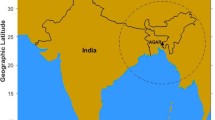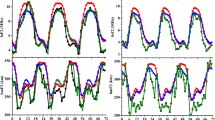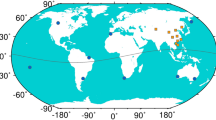Abstract
A comprehensive evaluation of Global Positioning System (GPS) Klobuchar, Galileo broadcast NeQuick2, international reference ionosphere (IRI) and global ionospheric map (GIM) models in estimating ionospheric total electron content (TEC) is performed using GPS-derived, constellation observing system for meteorology, ionosphere, and climate and JASON-2 TECs under various solar conditions in the Arctic and Antarctic. The performances of the four ionospheric models are first analysed for the overall polar regions. In addition, according to the temporal and spatial characteristics of the polar regions, the accuracies of the four models are evaluated for the polar days and nights, the Antarctic ice sheet (AIS) and the Arctic Ocean (AO), the Weddell Sea Anomaly (WSA) as well as for ionospheric storm. The results show that Klobuchar, NeQuick2, IRI2016 and GIM can mitigate the ionospheric delay by 28.69–29.41%, 44.57–56.09%, 43.38–55.99% and 67.17–77.56%, respectively. The performances of the four models during the polar days are obviously worse than those during the polar nights. In the AIS and AO, the Galileo broadcast NeQuick outperforms the GPS broadcast Klobuchar, and the root-mean-square error of IRI2016 performs almost the same as NeQuick2, but IRI2016 has a greater deviation. In addition, the GIM model can only mitigate the ionospheric delay by 46.81–56.72%, which is lower than other regions due to the lack of GPS ground station observations. Under the WSA conditions, the four models underestimate the real TEC to varying degrees, and the night-time deviations of the Klobuchar, NeQuick2 and IRI2016 models are significantly greater than the daytime deviations. The relative accuracy of four ionospheric models is lower during the ionospheric storm period than that in the ionospheric quiet period, especially the NeQuick2 and IRI2016 over the Antarctic.


















Similar content being viewed by others
References
Aquino M, Monico JFG, Dodson AH, Marques H, Franceschi GD, Alfonsi L, Romano V, Andreotti M (2009) Improving the GNSS positioning stochastic model in the presence of ionospheric scintillation. J Geodyn 83(10):953–966
Basu S, Groves KM, Basu S, Sultan PJ (2002) Specification and forecasting of scintillations in communication/navigation links: current status and future plans. J Atmos Sol Terr Phys 64(16):1745–1754. https://doi.org/10.1016/S1364-6826(02)00124-4
Bent RB, Llewellyn SK, Nesterczuk G, Schmid PE (1975) The development of a highly-successful worldwide empirical ionospheric model and its use in certain aspects of space communications and worldwide total electron content investigations. In: Effect of the ionosphere on space systems and communications, pp 351–379
Bi T, An J, Yang J, Liu S (2016) A modified Klobuchar model for single-frequency GNSS users over the polar region. Adv Space Res 59(3):833–842
Bidaine B, Warnant R (2011) Ionosphere modelling for Galileo single frequency users: illustration of the combination of the NeQuick model and GNSS data ingestion. Adv Space Res 47(2):312–322
Bilitza D (2001) International reference ionosphere 2000. Radio Sci 36(2):261–275
Bilitza D, Altadill D, Truhlik V, Shubin V, Galkin I, Reinisch B, Huang X (2017) International reference ionosphere 2016: from ionospheric climate to real-time weather predictions. Space Weather 15(2):418–429
Davies K, Hartmann GK (1997) Studying the ionosphere with the global positioning system. Radio Sci 32(4):1695–1703. https://doi.org/10.1029/97RS00451
Di Giovanni G, Radicella S (1990) An analytical model of the electron density profile in the ionosphere. Adv Space Res 10(11):27–30
European Commission (2015) European GNSS (Galileo) Open service-ionospheric correction algorithm for Galileo single frequency users. 1.2
Hernández-Pajares M, Juan JM, Sanz J, Orus R, Garcia-Rigo A, Feltens J, Komjathy A, Schaer SC, Krankowski A (2009) The IGS VTEC maps: a reliable source of ionospheric information since 1998. J Geodyn 83(3–4):263–275. https://doi.org/10.1007/s00190-008-0266-1
Hernández-Pajares M, Roma-Dollase D, Krankowski A, GhoddousiFard R, Yuan Y, Li Z, Zhang H, Shi C, Feltens J, Komjathy A, Vergados P, Schaer S, Garcia-Rigo A, Gmez-Cama JM (2016) Comparing performances of seven different global VTEC ionospheric models in the IGS context. In: IGS workshop, 8–12 Feb 2016, Sydney, Australia, International GNSS Service (IGS). International GNSS Service (IGS), pp 1–31
Hernández-Pajares M, Roma-Dollase D, Krankowski A, García-Rigo A, Orús-Pérez R (2017) Methodology and consistency of slant and vertical assessments for ionospheric electron content models. J Geodyn 2:1–10. https://doi.org/10.1007/s00190-017-1032-z
Horvath I (2006) A total electron content space weather study of the nighttime Weddell Sea Anomaly of 1996/1997 southern summer with TOPEX/Poseidon radar altimetry. J Geophys Res 111(A12):99–103
Jee G, Lee HB, Kim YH, Chung JK, Cho J (2010) Assessment of GPS global ionosphere maps (GIM) by comparison between CODE GIM and TOPEX/Jason TEC data: ionospheric perspective. J Geophys Res 115(A10):161–168
Jiang H, Wang Z, An J, Liu J, Wang N, Li H (2018) Influence of spatial gradients on ionospheric mapping using thin layer models. GPS Solut 22(1):2. https://doi.org/10.1007/s10291-017-0671-0
Kamide Y, Baumjohann W (1979) Magnetosphere-ionosphere coupling. J Geophys Res 84(A12):7239–7246
Klobuchar JA (1987) Ionospheric time-delay algorithm for single-frequency GPS users. IEEE Trans Aerosp Electron Syst 23(3):325–331
Klobuchar JA (1991) Ionospheric effects on GPS. GPS World 2(4):48–51
Komjathy A (1997) Global ionospheric total electron content mapping using the global positioning system. University of New Brunswick, Fredericton
Krankowski A, Wielgosz P, Hernándezpajares M, Garcíarigo A (2010) Present and future IGS ionospheric products. In: EGU General Assembly conference
Lanyi GE, Roth T (1988) A comparison of mapped and measured total ionospheric electron content using global positioning system and beacon satellite observations. Radio Sci 23(4):483–492
Leong SK, Musa TA, Omar K, Subari MD, Pathy NB, Asillam MF (2015) Assessment of ionosphere models at Banting: performance of IRI-2007, IRI-2012 and NeQuick 2 models during the ascending phase of Solar Cycle 24. Adv Space Res 55(8):1928–1940
Liu J, Chen R, Wang Z, Zhang H (2011) Spherical cap harmonic model for mapping and predicting regional TEC. GPS Solut 15(2):109–119
Liu J, Chen R, An J, Wang Z, Hyyppa J (2014a) Spherical cap harmonic analysis of the Arctic ionospheric TEC for one solar cycle. J Geophys Res 119(1):601–619. https://doi.org/10.1002/2013ja019501
Liu J, Chen R, Wang Z, An J, Hyyppä J (2014b) Long-term prediction of the Arctic ionospheric TEC based on time-varying periodograms. PLoS ONE 9(11):e111497
Mannucci A, Iijima B, Lindqwister U, Pi X, Sparks L, Wilson B (1999) GPS and ionosphere. URSI reviews of radio science. Jet Propulsion Laboratory, Pasadena
Orús R, Hernández-Pajares M, Juan JM, Sanz J, Garcı́A-Fernández M (2002) Performance of different TEC models to provide GPS ionospheric corrections. J Atmos Sol Terr Phys 64(18):2055–2062
Orús R, Hernández-Pajares M, Juan J, Sanz J (2005) Improvement of global ionospheric vtec maps by using kriging interpolation technique. J Atmos Sol Terr Phys 67(16):1598–1609
OS-SIS-ICD (2016). European GNSS (Galileo) Open service, signal-in-space interface control document, Issue 1.3, European Union and European Space Agency (ESA)
Skone S (1998) Wide area ionosphere grid modelling in the auroral region. Dissertation, University of Calgary
Venkatesh K, Fagundes PR, Jesus RD, Abreu AJD, Pillat VG, Sumod SG (2014) Assessment of IRI-2012 profile parameters by comparison with the ones inferred using NeQuick2, ionosonde and FORMOSAT-1 data during the high solar activity over Brazilian equatorial and low latitude sector. J Atmos Sol Terr Phys 121:10–23
Wang N, Yuan Y, Li Z, Li Y, Huo X, Li M (2016a) An examination of the Galileo NeQuick model: comparison with GPS and JASON TEC. GPS Solut 21(2):605–615
Wang N, Yuan Y, Li Z, Montenbruck O, Tan B (2016b) Determination of differential code biases with multi-GNSS observations. J Geodyn 90(3):209–228
Wang N, Yuan Y, Li Z, Huo X (2016c) Improvement of Klobuchar model for GNSS single-frequency ionospheric delay corrections. Adv Space Res 57(7):1555–1569
Wu Y, Jin SG, Wang ZM, Liu JB (2010) Cycle slip detection using multi-frequency GPS carrier phase observations: a simulation study. Adv Space Res 46(2):144–149
Wu X, Hu X, Wang G, Zhong H, Tang C (2013) Evaluation of COMPASS ionospheric model in GNSS positioning. Adv Space Res 51(6):959–968
Yue X, Schreiner WS, Hunt DC, Rocken C, Kuo YH (2011) Quantitative evaluation of the low Earth orbit satellite based slant total electron content determination. Space Weather 9(9):1–14
Zhang B, Teunissen PJG, Yuan Y, Zhang H, Li M (2017) Joint estimation of vertical total electron content (VTEC) and satellite differential code biases (SDCBs) using low-cost receivers. J Geod 92(4):401–413
Acknowledgements
The authors would like to acknowledge the International GNSS Services (IGS), the Polar Earth Observing Network (POLENET), the COSMIC Data Analysis and Archive Center (CDAAC) as well as the Center for Orbit Determination in Europe (CODE) for providing access to the observations. We would also like to acknowledge all the developers of the above-studied ionospheric models. Our deepest gratitude goes to the anonymous reviewers, editors and Professor Manuel Hernández-Pajares for their careful work and thoughtful suggestions that have helped improve this paper substantially. This research was supported by the Natural Science Funds of China (Nos. 41776195, 41231064, 41531069 and 41574015) and the National Key Research Development Program of China with Project No. 2016YFE0202300.
Author information
Authors and Affiliations
Corresponding author
Rights and permissions
About this article
Cite this article
Jiang, H., Liu, J., Wang, Z. et al. Assessment of spatial and temporal TEC variations derived from ionospheric models over the polar regions. J Geod 93, 455–471 (2019). https://doi.org/10.1007/s00190-018-1175-6
Received:
Accepted:
Published:
Issue Date:
DOI: https://doi.org/10.1007/s00190-018-1175-6




